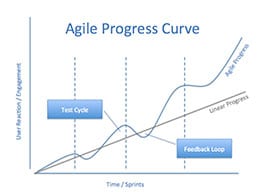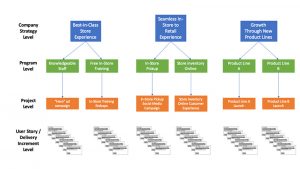Guest Post by Steve Gilbert
OK, you are thinking, what the heck does a Police song from the 1979 have to do with Agile Marketing? We all know the genius of Sting, the iconic songwriter, but was he really 35 years ahead of the curve for agile? Well let’s see.
Here are 20 words from the chorus describing the mixed feelings one might have while venturing into outer space….
Giant steps are what you take
Walkin’ on the moon
I hope my leg don’t break
Walkin’ on the moon
Now that the unforgettable and fabled tune is solidly stuck in your head, are you able to make the connection to effective Agile Marketing? Not quite yet? Well let us take a look at the following diagram, maybe that will help.

Picture the “Giant steps you take” as the wavy Agile Progress line in the chart. Each peak represents another bound while the 1/6th gravity environment of the Moon accelerates you toward your effortless increase in customer engagement and response. These large advances in marketing effectiveness, message to market or other target activity are easy to make when empowered by the iterative and adaptive approach of Agile Marketing. You take “one small step” and it is amplified into a “giant leap”.
But how do you know that your small steps will be amplified into “giant leaps”? Well that’s the secret isn’t it and ultimately where the genius of Sting really shows when he says ‘I hope my leg don’t break’ when ‘walking on the moon’.
Even Sting may not have realized it when he was writing this song, but he was profoundly describing the customer feedback loop of the Agile Process. This is undeniably the most significant yet most difficult part of any agile engagement, taking the time to listen to customers and act on their feedback.
Let’s put this concept into a real world example. Imagine that your company is experiencing an unexpected viral event (a positive one) where you are creating an explosion of traffic to your website. This event will be short lived (maybe 48 hours) but presents a positive opportunity to engage with a new audience.
Because this event is unexpected, many companies typically would not make a substantial change to their site but simply let the viral activity run through a standard experience. In some cases the reaction would be a 12-24 hour turn around fire drill with approved updated content released after missing the initial spike or fresh visitors. Either way it is a one shot approach to get it right and hit or miss on the content to create a longer tail for the event.
Now, if your organization is leveraging an Agile Marketing approach, where empowered team members constantly review page activity and make incremental real time alterations to your pages, giant steps are indeed possible.
Picture this scenario. Your team intercepts the spike in activity within minutes of the viral activity. Then, they quickly alter your homepage or microsite experience to align with the traffic drivers and capture the visitors attention. As the wave of traffic continues to increase you leverage this unique opportunity to aggressively test different messages, offers or images using your A/B testing model. The result is that your team has maximized this opportunity, leveraging the increased traffic to gather an incredible amount of customer feedback in a very short period of time. In the greater scheme of things this is a low risk situation given the alternative of doing nothing.
The message: Create an environment where teams are comfortable in altering the experience by listening to visitors and using the data to take educated risks on message and content. This way they find out quickly and in a data driven way what offers are engaging and what areas of the experience are compelling.
If this real time example does not seem like something immediately accomplishable within your organization, you can take the same scenario and make it more ‘real’ where you slow down the timeline to say a week or month when a press event increases site activity but then still apply the same ‘feedback loop’ principal. Either way, by using a “process of customer discovery over static prediction”, you can see how building an organization around listening to customers and providing the freedom to innovate sits at the core of Agile Marketing and will offer you a competitive advantage when developing content and messaging that effectively target your key persona.
To wrap this up and help you to implement this mindset into your marketing organization we will look back to Sting one more time for guidance and wisdom on Agile.
Giant steps are what you take
Walking on the moon
I hope my legs don’t break
Walking on the moon
We could walk forever
Walking on the moon
We could be together
Walking on, walking on the moon
This message is about enablement and empowerment of the agile teams. “We could walk forever” and “We could be together” both use the term we and expound on the endless possibilities of Agile. As a manager, team leader or executive, you have to empower your teams to try things (albeit small things) fearlessly, give them space to be creative, put those early ideas to work in controlled environments, while staying within bounds of the sprint cycles, budget or other fences that may be around them. Giving them this freedom to occasionally have that ‘broken leg’ while gathering meaningful information to improve results is the true secret of Agile Marketing. If you listen to your customers you can be sure “Giant steps” you too will take, “Walking on the moon”.
Steve Gilbert is a Digital and Agile Marketing addict who enjoys sailing and coaching hockey in his ‘spare time’. For more insight into these and other topics you can follow Steve @stevegilbert4 or on LinkedIn @ www.linkedin.com/pub/steve-gilbert



A great post and reminder of core principals and practices in marketing as well as working with customers. Know (or get to know) your customers! Engage and listen to them. This is key. They will tell you what they want and what they need. Be sure to respond quickly.
Hi Karen – Thank you for the feedback. You are absolutely correct on this one. In my mind the absolute basic assumption and root of Agile is built upon that customer feedback loop, something we have to be very careful not to overlook as we evolve our Agility.
Pingback: Amplify Your Agile by Walking on the Moon - Agi...
Pingback: Amplify Your Agile by Walking on the Moon - Agi...